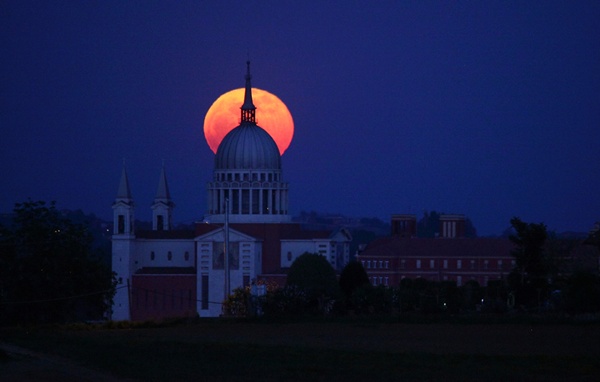The Sky This Week from October 11 to 20 – Astronomy Magazine
The Moon and the Basilica
The Full Moon of April 15, 2014, rises behind the Basilica of Don Bosco near Turin, Italy. This week’s Full Moon, also known as the Hunter’s Moon, rises only about 30 minutes later each successive night.
Stefano De Rosa
Full Moon officially arrives at 5:08 p.m. EDT, but it will look completely illuminated all night. You can find it rising in the east shortly after sunset and peaking high in the south around 1 a.m. local daylight time. It dips low in the west by the time morning twilight starts to paint the sky. The Moon lies in southeastern Pisces near that constellation’s border with Cetus. October’s Full Moon also goes by the name “Hunter’s Moon.” In early autumn, the Full Moon rises about half an hour later each night compared with a normal lag close to 50 minutes. The added early evening illumination supposedly helps hunters track down their prey.
Monday, October 14
Although autumn began three weeks ago and the stars of winter’s Orion now rule the morning sky, the Summer Triangle remains prominent on October evenings. Look high in the west after darkness falls and your eyes will fall on the brilliant star Vega in the constellation Lyra the Harp. At magnitude 0.0, Vega is the brightest member of the triangle. The second-brightest star, magnitude 0.8 Altair in Aquila the Eagle, lies some 35° southeast of Vega. The asterism’s dimmest member, magnitude 1.3 Deneb in Cygnus the Swan, stands about 25° east-northeast of Vega. For observers at mid-northern latitudes, Deneb passes through the zenith around 8 p.m. local daylight time, just as the last vestiges of twilight disappear.
Tuesday, October 15
After a three-month hiatus lost in the Sun’s glare, Venus returns to view after sunset in mid-October. It’s not easy to see, however — it stands just 2° high in the west-southwest a half-hour after sundown. Luckily, the inner planet shines brilliantly at magnitude –3.8 and should show up if you have a haze-free sky and unobstructed horizon. Despite this pedestrian start to its evening apparition, Venus will be a glorious sight this coming winter and spring.
Wednesday, October 16
Uranus reaches opposition in just two weeks, and it is already a tempting evening target. The ice giant world rises during twilight and climbs 30° above the eastern horizon by 9:30 p.m. local daylight time. The magnitude 5.7 planet lurks among the background stars of southern Aries. Use binoculars to find the planet 2.7° south of the similarly bright star 19 Arietis. A telescope reveals Uranus’ blue-green disk, which spans 3.7″. To learn more about viewing Uranus and its outer solar system cousin, Neptune, see “Observe the ice giants” in October’s Astronomy.
Thursday, October 17
The variable star Algol in Perseus reaches minimum brightness at 5:27 a.m. EDT. If you start watching it late yesterday evening, you can see its brightness diminish by 70 percent (its magnitude drops from 2.1 to 3.4) over the course of about five hours. This eclipsing binary star runs through a cycle from minimum to maximum and back every 2.87 days. Algol appears in the northeast during the evening hours and passes nearly overhead around 2 a.m. local daylight time.
Friday, October 18
Saturn remains a glorious sight this week. The ringed planet resides among the background stars of Sagittarius the Archer, a region that appears 25° high in the south-southwest as twilight fades to darkness and doesn’t set until close to 11 p.m. local daylight time. Saturn shines at magnitude 0.5 and appears significantly brighter than any of its host constellation’s stars. Although a naked-eye view of the planet is nice, seeing it through a telescope truly inspires. Even a small instrument shows the distant world’s 16″-diameter disk and spectacular ring system, which spans 37″ and tilts 25° to our line of sight.






